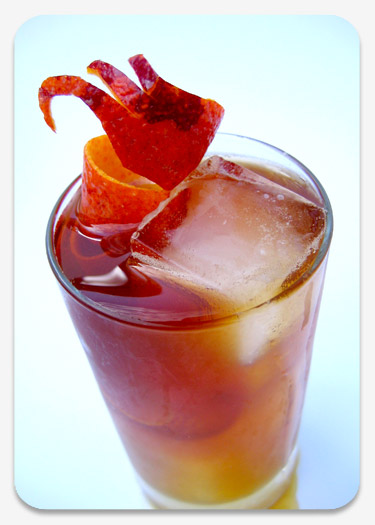
So, after a little over 5 months in the barrel, my rye whisky is finally mature enough to exit, I figure. You can read about my at-home aging exploits here and here. I originally dropped 1.5L of Wasmund’s Rye Spirit into this small oak barrel, and I’ve been letting it sit until now.
As soon as I evacuated the whisky(spelled that way by Wasmund’s request), the first thing I noticed was the volume. Aside of the small pours I’ve been taking out here and there for myself and a few of my friends, I was very surprised at the Angel’s Share. I started the experiment with two 750mL bottles, and the result is less than one of those bottles. I suppose it makes sense: the increased surface area of the small barrel which allows me to mature a spirit much quicker than a big distillery also accelerates the rate at which the alcohol (and water) evaporates through the barrel. So, my end product is not great in amount, but great in flavor instead.
I began with Wasmund’s Rye, but the version I had was almost completely unaged, clear as water. What I have now is a whiskey that’s darker than any I’ve ever seen on the shelves. You can see my short review of the unaged whisky here. And now, a review of the final product:
Wasmund’s Rye Spirit, at-home aged

Smell
The smell of this is drastically different than from the start, although it's still fairly simple. Five months ago it smelled grassy and pungent, assaulting the nose with alcohol. Now, it smells overwhelmingly of smoke and oak, with still the mischievous tones of butterscotch, as I began to notice 2 months ago.
Taste
The smoke and oak still dominate here. It’s impossible to escape the smoke of Wasmund’s whisky, especially considering that they smoke their malted barley with fruitwoods. The pungency of the rye is still there. It still tastes fairly high proof, perhaps still over 100. (Really?? I would have thought just about all of it had evaporated :D) The butterscotch smell does not carry over to the palate… instead you taste honey and spice. You can’t really buy whiskies quite this complex unless you begin to pay over $100… and come to think about the spending for this project… I just about did.
Ice cube
The high proof warrants the ice cube, but the taste of the stuff doesn’t change too much with water. The only difference I notice is that both the pungent rye and smoke become more pronounced. Fabulous!
What’s next for the barrel?
I’ll tell you what’s next: rum. Lots of it. I do hate conforming, but I’m hardly one to shirk tradition. Rum fans know that aged rum is often matured in oak barrels that were previously used for whiskey… bourbon, most often. Well, all I got is a rye barrel, so I’m using that.
I’ve been given conflicting advice on how exactly to begin aging this rum. Do I try to re-char the inside of the barrel? Do I let the barrel air out? Do I “flush” the barrel with water for a few days?
I decided to put in the rum without re-charring the barrel. I really don’t have the resources (or expertise) to do it, not to mention that this small barrel wasn’t designed to be handled so. I didn’t flush the barrel; I want a strong flavor to the rum I’m putting in it, so all I did was “air out” the barrel for about 12-24 hours, and then began to pour.
Pour what? Cruzan Estate Light. Two full liters of it. Cruzan (CROO-zhun) is a company based in St. Croix in the US Virgin Islands, and their rums are all fairly subtle in flavor, and are often compared to rum from Puerto Rico. Cruzan Estate Light, their lightest product, is one of the best rum values of which I know. When anybody asks me which rum they should buy for Mojitos, or cola, etc... I always tell them Cruzan. (Even though Cruzan just limited their Estate Light aging time from 2 years down to 14 months, it’s still great.) Cruzan is usually cheaper than Bacardi (depending on your state’s distribution system), and while Bacardi Superior usually tastes and smells like rubbing alcohol, the Cruzan is so good that it can be sipped with an ice cube. To me, Cruzan tastes mostly woody with hints of almond and vanilla. You’ll notice that it’s not completely clear, but has a nice beige tint to it. I look forward to seeing how it holds up under the oakey onslaught inside the barrel. So, for the love of your savior, never buy anything Bacardi again (unless it’s Bacardi 8 or Bacardi Solera or another of the few limited products they make), and buy Cruzan Estate Light instead.
So there it is. The second batch of spirit is already aging in the Little Barrel that Could. Any suggestions on what I should age after the rum? I'm thinking Port or Sherry.































